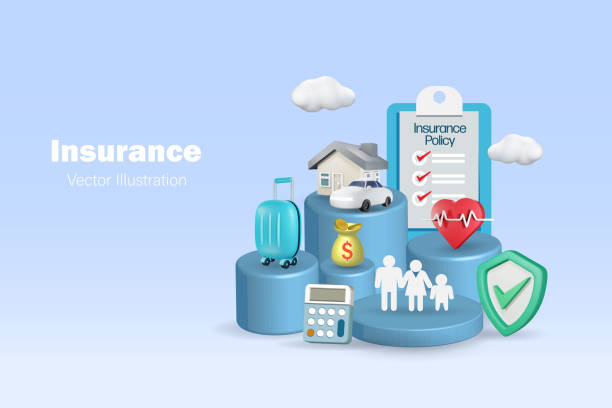Insurance is an essential tool for financial protection, offering a safety net against unforeseen circumstances such as accidents, illness, or property damage. However, navigating the complex world of insurance can be overwhelming, and many people make costly mistakes when purchasing coverage. These mistakes often stem from a lack of understanding, misinformation, or an overly hasty decision-making process.
To help you make informed choices, here are some of the most common mistakes people make when buying insurance—and how to avoid them.
1. Not Understanding What Insurance Covers
One of the biggest mistakes people make is not fully understanding what their insurance policy covers—or doesn’t cover. Policies often include a list of inclusions (what’s covered) and exclusions (what’s not covered), and failing to review these details can lead to unpleasant surprises during a claim.
- Example: A homeowner assumes their policy covers flood damage, only to discover after a natural disaster that floods are excluded.
- How to Avoid: Take the time to carefully read and understand the terms of your policy. Don’t hesitate to ask your insurance provider for clarification on coverage and exclusions.
2. Buying Based Solely on Price
While affordability is a significant factor, choosing an insurance policy based purely on the lowest premium is a common mistake. Lower premiums often come with limited coverage, higher deductibles, or fewer benefits, which can leave you underinsured.
- Example: A driver opts for the cheapest auto insurance policy but finds it doesn’t cover theft or comprehensive damage.
- How to Avoid: Look beyond the price and consider the value of the coverage offered. Compare policies from multiple providers and weigh the cost against the benefits and risks.
3. Failing to Assess Your Needs
Another common mistake is purchasing insurance without evaluating your personal or financial needs. Insurance isn’t one-size-fits-all; the type and level of coverage you require depend on factors such as your lifestyle, family situation, and long-term goals.
- Example: A young professional buys life insurance with minimal coverage, not accounting for future needs like starting a family.
- How to Avoid: Assess your current and future needs before purchasing a policy. For example, consider whether you need life insurance to support dependents, health insurance for specific medical conditions, or home insurance for valuable belongings.
4. Over- or Under-Insuring
Striking the right balance in coverage is crucial. Over-insuring means paying for unnecessary coverage, while under-insuring leaves you exposed to significant financial risks.
- Example (Over-Insuring): Purchasing excessive life insurance coverage when you have no dependents.
- Example (Under-Insuring): Opting for minimal health insurance that doesn’t adequately cover major medical expenses.
- How to Avoid: Work with an insurance advisor or use online calculators to determine appropriate coverage levels based on your circumstances.
5. Ignoring Policy Details
Many people purchase insurance without thoroughly reviewing the fine print, including terms, conditions, and exclusions. This oversight can result in misunderstandings during claims or dissatisfaction with the policy.
- Example: A traveler buys travel insurance but doesn’t notice that pre-existing medical conditions are excluded from coverage.
- How to Avoid: Take the time to review the policy document carefully. Pay attention to clauses like waiting periods, deductibles, and specific exclusions that could impact your coverage.
6. Skipping Comparison Shopping
Failing to compare policies from different providers is another common mistake. Insurance offerings vary widely in terms of premiums, coverage, and customer service, and sticking to the first option you come across could mean missing out on a better deal.
- Example: A homeowner renews their policy with the same insurer each year without exploring whether competitors offer better rates or coverage.
- How to Avoid: Use online tools and comparison websites to evaluate multiple insurance providers. Consider factors like claim settlement ratios, customer reviews, and policy benefits in addition to pricing.
7. Neglecting to Update Policies
Life circumstances change, and so do your insurance needs. Many people fail to update their policies after major life events, leaving gaps in their coverage.
- Example: A couple doesn’t increase their life insurance coverage after having a child, leaving their family under-protected.
- How to Avoid: Review your insurance policies regularly and make updates when significant changes occur, such as marriage, a new job, a home purchase, or the birth of a child.
8. Overlooking Deductibles
A deductible is the amount you must pay out of pocket before your insurance kicks in. Choosing a policy with a high deductible to lower premiums can be risky if you don’t have enough savings to cover the deductible when needed.
- Example: A driver selects an auto insurance policy with a $2,000 deductible but struggles to afford repairs after an accident.
- How to Avoid: Balance the deductible with your financial situation. Opt for a deductible you can comfortably pay in case of an emergency.
9. Misjudging the Importance of Riders and Add-Ons
Riders and add-ons enhance your insurance policy by providing additional coverage tailored to your needs. Many people overlook these options, leaving potential gaps in their protection.
- Example: A homeowner skips adding flood insurance to their policy, assuming it’s unnecessary, and suffers significant financial losses during a flood.
- How to Avoid: Discuss available riders with your insurer and assess whether they’re relevant to your situation. Common examples include critical illness riders, personal accident riders, and zero-depreciation add-ons for auto insurance.
10. Focusing Only on Short-Term Benefits
Insurance is a long-term financial tool, but many buyers focus only on short-term savings or benefits, neglecting the policy’s future implications.
- Example: A policyholder chooses a term life insurance policy with the shortest term to save on premiums but doesn’t consider the cost of renewing or replacing the policy later in life.
- How to Avoid: Think about how the policy aligns with your long-term goals. For example, a whole life or universal life policy may be better suited for those seeking lifelong coverage and investment benefits.
11. Failing to Research the Insurer
Not all insurance providers are created equal. Failing to research the reputation, financial strength, and claim settlement record of an insurer can lead to issues during the claim process.
- Example: Choosing an insurer with a low claim settlement ratio results in delayed or denied claims when you need coverage most.
- How to Avoid: Research the insurer thoroughly. Look for customer reviews, ratings, and claim settlement statistics to ensure reliability.
12. Delaying the Purchase of Insurance
Procrastination can be costly. Waiting too long to buy insurance often results in higher premiums, especially for age-sensitive policies like health or life insurance. It may also lead to coverage denial if your health deteriorates.
- Example: A young individual postpones buying health insurance, only to face higher premiums after developing a medical condition.
- How to Avoid: Purchase insurance as early as possible, even if it means starting with a basic policy. Early coverage ensures lower premiums and access to more options.
Final Thoughts
Insurance is a vital part of financial planning, but buying the right policy requires careful consideration and research. By avoiding common mistakes like focusing solely on price, neglecting policy details, or failing to assess your needs, you can make informed decisions that provide effective coverage and long-term peace of mind.
Take the time to evaluate your unique situation, compare options, and seek professional advice if needed. Remember, the goal of insurance is to protect you and your loved ones from financial hardship—so make sure your choices align with that purpose.

